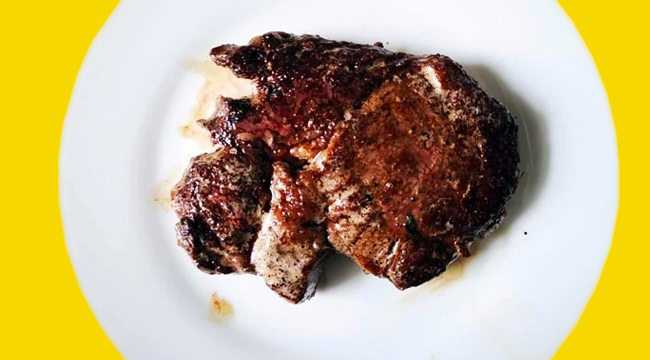
Learning how to cook a steak to perfection is a long road. It takes a few tools that are, kind of, essential. It also demands prime ingredients. There’s no getting around this. And, as always, a perfect dish takes patience and practice. A great steak lives and dies by temperatures: Room temp, searing temp, pan temp, internal temp, etc. It’s … a lot. But, it’s in that matrix of temperatures that you’ll either soar to succulent heights or crash and burn into the leathery depths.
So, here’s what you need to know to cook a perfect steak. One, get the right tools. You need a cast iron skillet. Grilling a steak is fine and all but the sear you get from the skillet and the safe haven it provides for the fats to mingle is crucial to flavor and texture. Next, season generously. Take this as a litmus: Most folks who’ve worked a long time in pro kitchens will always tell you that the average layperson would be shook if they knew who much salt we actually use in the back of the house. So salt it a lot. Use a lot of pepper too.
Lastly, cooking the steak comes down to a little technique. You need to sear it at an amazingly high heat, lower that heat, and, then, cook the steak while basting it in butter. Then it has to rest. If you don’t rest it, forget it. From there, the way you sauce or not is totally up to you. I’ve included an au Poivre here because that’s what I was in the mood for but, really, it’s up to you.
Let’s dive in and cook the perfect ribeye.
I: Ingredients
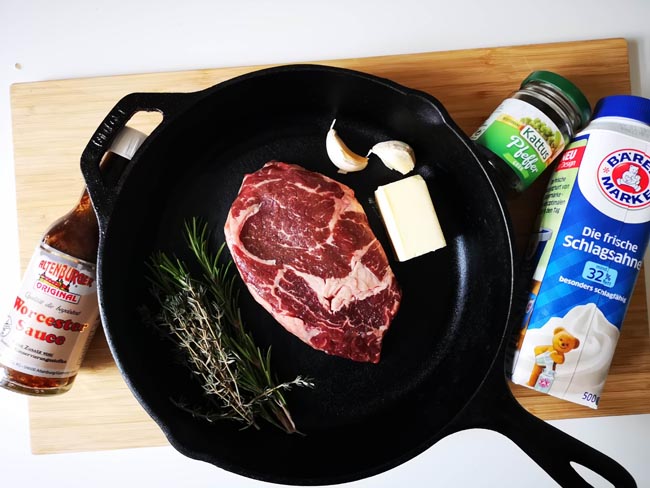
I made a promise to myself to eat more wild foods in 2019. So, I’m using a 300g/10-oz. bison ribeye cut. This is a serving for two people. If you can’t source bison, by all means, use grass-fed beef.
I got a huge whole ribeye section around the first of the year. I cut a whole bunch of steaks off and left a nice portion to do a Bison Prime Rib. I generally salt my steaks and vacuum seal them before they go in the freezer. I believe that this gives the meat a richer feel. If you don’t have time to salt, seal, and freeze your steaks, don’t worry. If you’re interested, give it try. I think you’ll like it.
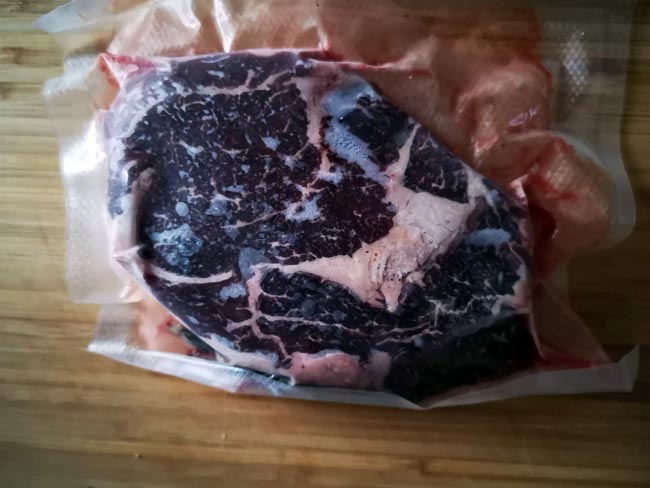
II: Prep
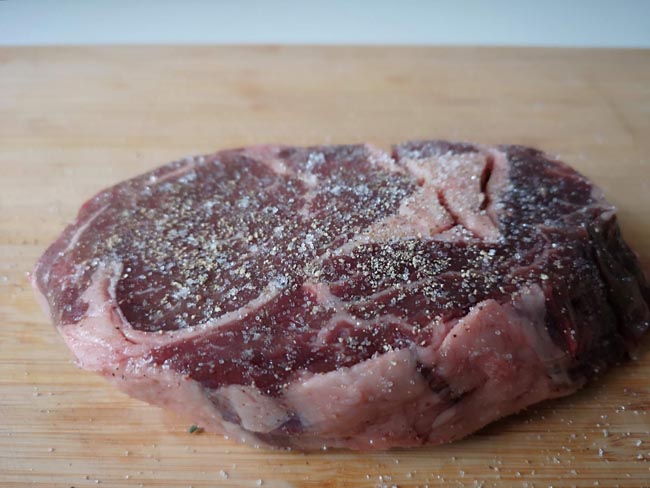
Okay, so I thaw my steak and let it reach room temp. This is one of the most crucial steps (right up there with resting your meat). If you don’t start out with a room temperature piece of meat, your searing and cooking will be subpar. Your steak will cool down the pan plus its internal temp will be slower to rise and neither of those are ideal.
In the meantime, I set up my mise en place. I get out a knob of unsalted butter, peel two garlic cloves, grab a few sprigs of fresh rosemary and thyme, and get my heavy cream, Worcester, and pickled peppercorns ready next to my stove. It’s important to have everything ready ahead of time because this recipe requires that you keep moving.
Once the meat is room temp, I generously add another layer of Alpine Salt and cracked black pepper on both sides. Prep done.
III. Cook
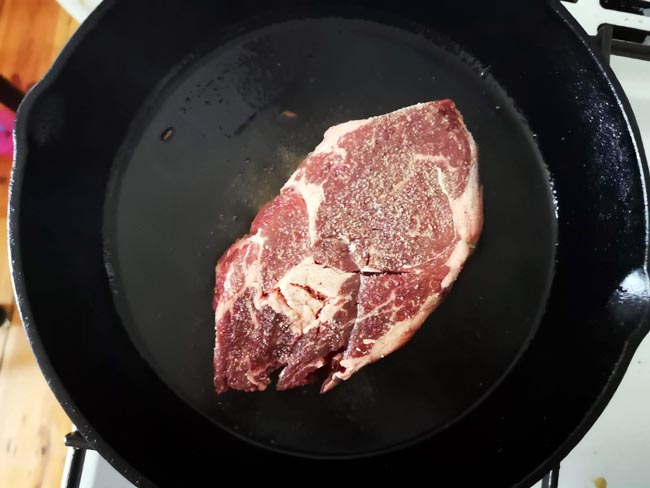
This is where the technique comes in. You’re basically going to cook the steak three times: Sear, baste, and rest. You’re also going to need to dial this in. I’m using a gas stove top. So any time reference I give below is going to change slightly depending on what you’re using at home. In the end, if you want a wonderful medium rare steak, your aim is 130f. That means bringing the steak to 120-125f in the pan. It’ll increase in temp about 5-8 degrees once you take it off the heat.
First things first, add a good glug of (cooking) olive oil to your cast iron skillet. You want a solid layer coating the whole bottom of the pan. Set your burner on its highest setting and get that sucker hot. When it just starts to smoke, its ready. Lay in your steak with a pair of tongs. Let it sit there for a good 30 seconds. I like to move the steak around the pan a little to even out the sear. After about another 30 seconds, it should be ready to turn over. Repeat that process until you have a nice Maillard sear on both sides. You’re looking at one-minute each side at most.
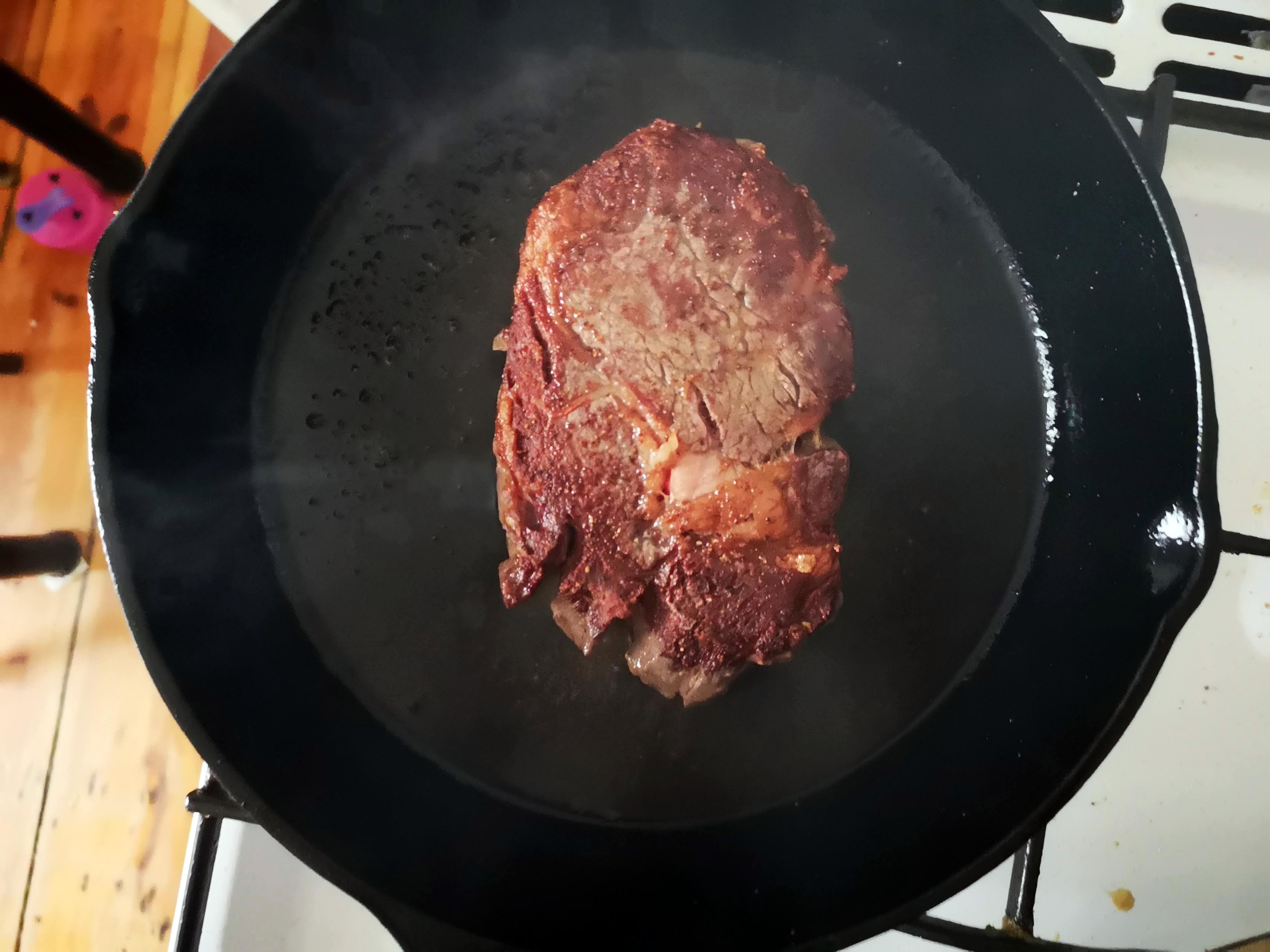
Remove the steak from the heat and turn your heat down to medium. Pour off the excess cooking oil. You want to leave a thin layer at the bottom where the fond is. I leave my skillet off the heat for a good minute just to let the intense heat lose its edge.
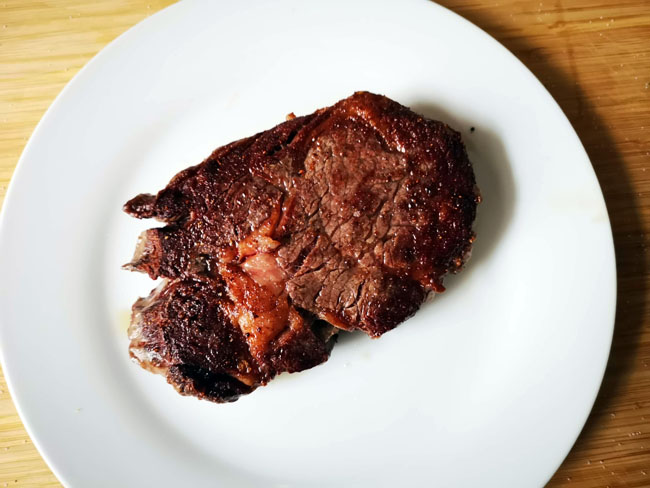
Next, drop in the butter. Move it around the skillet to draw up all the fond from the sear. As soon as it’s pretty much melted, add in your aromatics and garlic. They should not burn … ever.
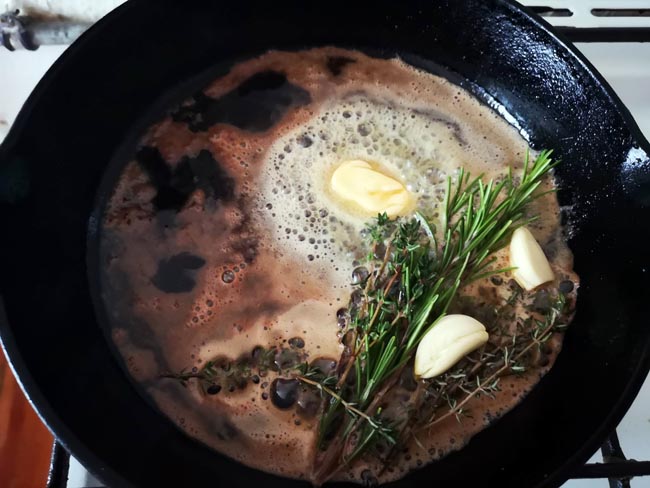
Bring your steak back into the skillet. It should sizzle. Use a spoon to baste the steak for about 60 to 90 seconds on each side. Tip your skillet toward you. This allows the butter to pool nearest you and you can spoon the butter over more easily. Basically, you need to be over the stove the whole time spooning butter over that slab.
I work by feel and time mostly. Some people like comparing the feel of their steak to the feel of that little area of webbing between the thumb and forefinger to gauge steak doneness. Generally, the more give there is which equates to the rarer the steak is. This, generally, works and is good for newbie cooks. Once you’ve dialed in the heat your stove puts out and your times, you should be able to have enough confidence in the time the steak spends in the pan. In reality, I know I’m working around a 90 second to a two-minute window on each side for basting in butter but I’m feeling the give of the steak with my spoon too. It’s a lot of feel by instinct which just comes from doing it a million times.
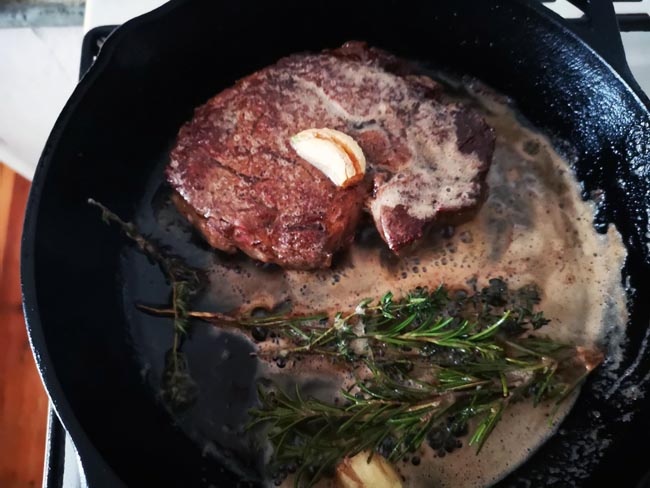
When it feels right (plenty of firm give), remove the steak from the skillet and place it on a plate or board to rest. Don’t cut it. Don’t poke it with a temperature gauge. If you pierce the meat, the juices will flow away and produce a subpar final product. Trust the technique.
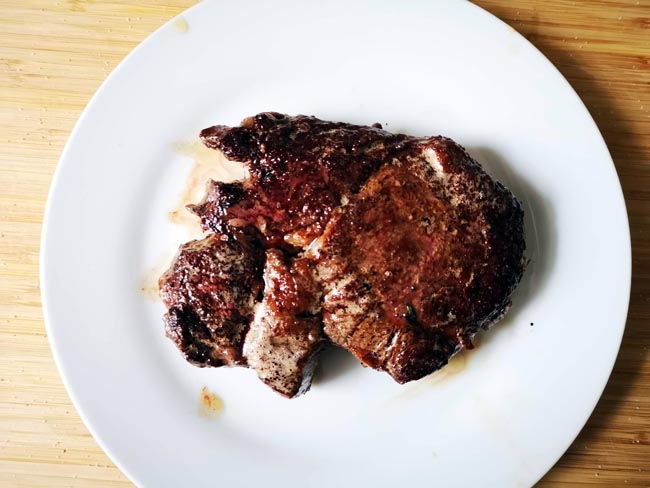
IV. Sauce
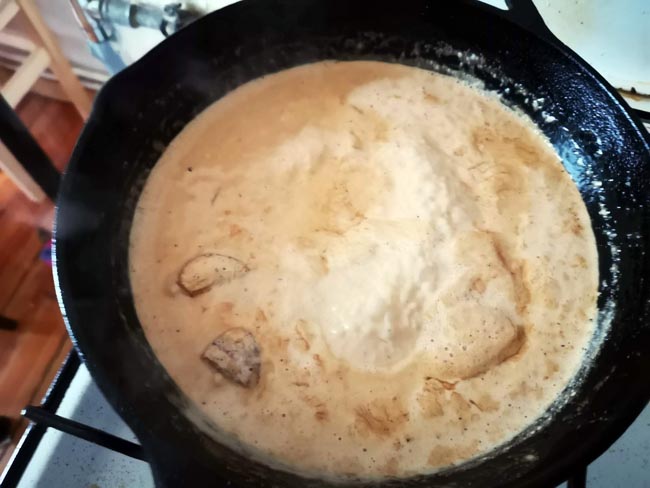
What’s great about resting a steak is that it gives you exactly enough time to whip up a quick pan sauce. Though, to be fair, you don’t have to make a pan sauce. You can just let your steak rest for five minutes (at least) and then dive in. There is, after all, plenty of butter basted all over it already.
Still, a sauce is a nice touch and you have time to execute one well. The first step is to remove the sprigs of thyme and rosemary. Don’t worry about getting out every little bit. Next, pour off the excess butter and leave a thin layer at the bottom of the pan along with the two cloves of garlic.
Turn the burner down the medium-low. Add in about one-quarter cup of Worcester sauce. It should sizzle when it hits the pan. Next, add in one cup of heavy cream. Use your spoon to stir vigorously as the cream starts to simmer. The sauce should have a lighter color at first. As it cooks, it’ll darken.
I then crack in a lot of black pepper — maybe ten or 12 cranks — while the sauce is simmering at a good rate. At this point, it should already be thickening up as you stir with your spoon. Lastly, I add in three teaspoons of pickled green peppercorns with a little of the brine in the bottom of the spoon.
You let that simmer for a few minutes until it starts to darken and thicken. That’s it.
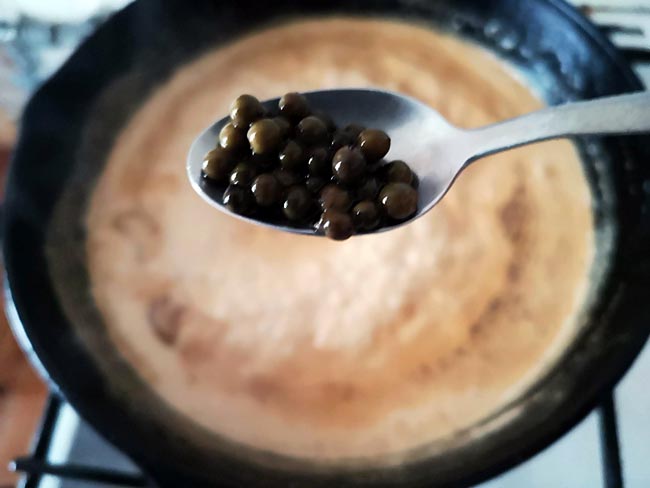
V. Serve
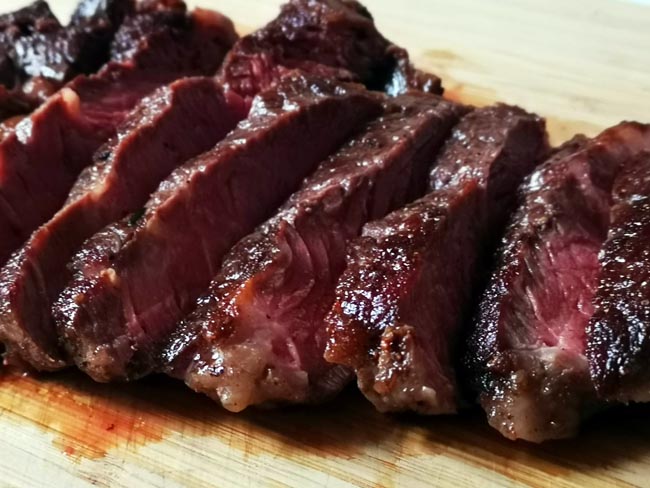
I like serving steak on big boards, especially when it’s a steak meant for two. I slice the steak into about half-inch slices and fan it out a bit. The steak should be pink as close to the edge as possible. Of course, the best way to do this is with a sous vide circulator. Still, you can see in the photo below, you can get pretty damn close to edge-to-edge pink in a skillet.
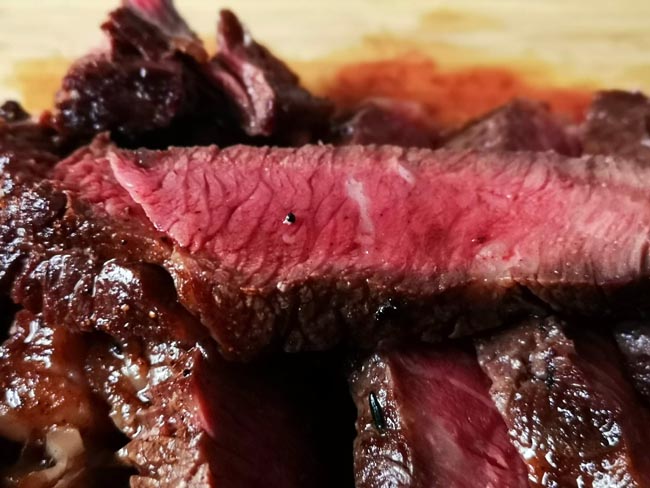
I use my trusty spoon to spoon the sauce onto the steak. I tip it to the side so I can get as many of the peppercorns as possible. I fish the garlic cloves out and set them on the side of the steak with plenty of au Poivre over them. It’s ready.
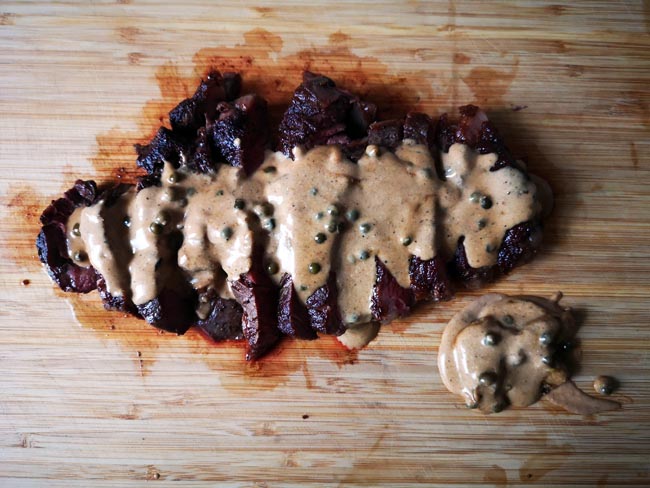
The beauty of this dish is the depth of umami present in the meat counterpointed by the creamy and piquant sauce. The peppercorns literally pop in your mouth with little bursts of spice. It’s fun and delicious.
The meat is pitch perfect. There’s a solid savoriness here that’s supremely juicy and melt-in-your-mouth tender. And, since this steak was brought up to room temp, flash seared, brought up to a low temp (120f), and then brought up to a final temp (130f) while resting, it’s pretty much as close to perfect as you can get in a home kitchen. The doneness is set and remains as luscious from the first bite to the last.
Shopping List:
- One Ten-ounce Ribeye Steak (Bison or Grass-fed Beef)
- Two cloves Garlic
- Fresh Rosemary
- Fresh Thyme
- Large tablespoon Unsalted Butter
- Olive Oil
- Alpine Salt
- Cracked Black Pepper
- Pickled Green Peppercorns
- 1/4 cup Worcester Sauce
- One cup Heavy Cream
Kitchen List:
- 10-inch Cast Iron Skillet
- Tongs
- Large Tablespoon
- Teaspoon
- Chef’s Knife
- Wooden Board
- Plate






